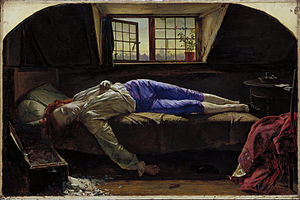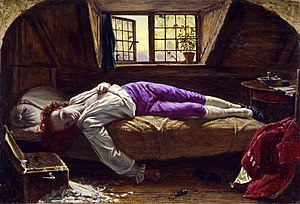
Sir John Everett Millais, 1st Baronet was an English painter and illustrator who was one of the founders of the Pre-Raphaelite Brotherhood. He was a child prodigy who, aged eleven, became the youngest student to enter the Royal Academy Schools. The Pre-Raphaelite Brotherhood was founded at his family home in London, at 83 Gower Street. Millais became the most famous exponent of the style, his painting Christ in the House of His Parents (1849–50) generating considerable controversy, and he produced a picture that could serve as the embodiment of the historical and naturalist focus of the group, Ophelia, in 1851–52.

The Pre-Raphaelite Brotherhood was a group of English painters, poets, and art critics, founded in 1848 by William Holman Hunt, John Everett Millais, Dante Gabriel Rossetti, William Michael Rossetti, James Collinson, Frederic George Stephens and Thomas Woolner who formed a seven-member "Brotherhood" partly modelled on the Nazarene movement. The Brotherhood was only ever a loose association and their principles were shared by other artists of the time, including Ford Madox Brown, Arthur Hughes and Marie Spartali Stillman. Later followers of the principles of the Brotherhood included Edward Burne-Jones, William Morris and John William Waterhouse.

Sir Edward Coley Burne-Jones, 1st Baronet, was an English painter and designer associated with the Pre-Raphaelite Brotherhood's style and subject matter.
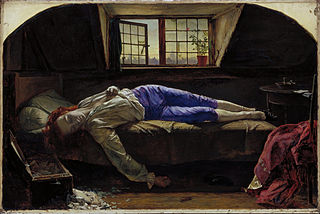
Thomas Chatterton was an English poet whose precocious talents ended in suicide at age 17. He was an influence on Romantic artists of the period such as Shelley, Keats, Wordsworth and Coleridge.

Frederic George Stephens was a British art critic, and one of the two 'non-artistic' members of the Pre-Raphaelite Brotherhood.

William Dyce was a Scottish painter, who played a part in the formation of public art education in the United Kingdom, and the South Kensington Schools system. Dyce was associated with the Pre-Raphaelite Brotherhood and played a part in their early popularity.

Henry Wallis was a British Pre-Raphaelite painter, writer and collector.

Simeon Solomon was a British painter associated with the Pre-Raphaelites who was noted for his depictions of Jewish life and same-sex desire. His career was cut short as a result of public scandal following his arrests and convictions for attempted sodomy in 1873 and 1874.

Philip Hermogenes Calderon was a British painter of French birth (mother) and Spanish (father) ancestry, who initially worked in the Pre-Raphaelite style before moving towards historical genre painting. He was Keeper of the Royal Academy in London.

John Brett was a British artist associated with the Pre-Raphaelite movement, mainly notable for his highly detailed landscapes.

The Last of England is an 1855 oil-on-panel painting by Ford Madox Brown depicting two emigrants leaving England to start a new life in Australia with their baby. The painting has an oval format and is in the Birmingham Museum and Art Gallery.

The Scapegoat (1854–1856) is a painting by William Holman Hunt which depicts the "scapegoat" described in the Book of Leviticus. On the Day of Atonement, a goat would have its horns wrapped with a red cloth – representing the sins of the community – and be driven off.
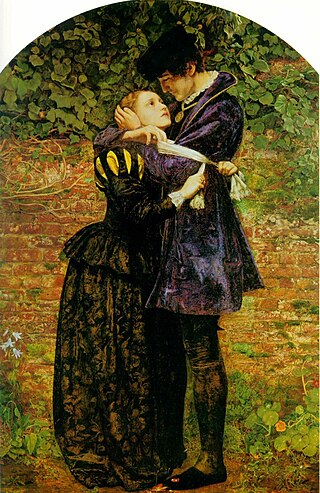
A Huguenot, on St. Bartholomew's Day, Refusing to Shield Himself from Danger by Wearing the Roman Catholic Badge (1851–52) is the full, exhibited title of a painting by John Everett Millais, and was produced at the height of his Pre-Raphaelite period. It was accompanied, at the Royal Academy of Arts in London in 1852, with a long quote reading: "When the clock of the Palais de Justice shall sound upon the great bell, at daybreak, then each good Catholic must bind a strip of white linen round his arm, and place a fair white cross in his cap.—The order of the Duke of Guise." This long title is usually abbreviated to A Huguenot or A Huguenot, on St Bartholomew's Day.

The Stonebreaker is an 1857 oil-on-canvas painting by Henry Wallis. It depicts a manual labourer who appears to be asleep, worn out by his work, but may have been worked to death.
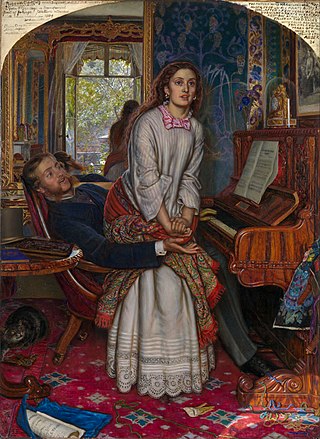
The Awakening Conscience (1853) is an oil-on-canvas painting by the English artist William Holman Hunt, one of the founders of the Pre-Raphaelite Brotherhood, which depicts a woman rising from her position in a man's lap and gazing transfixed out the room's window.

Dante's Dream is a painting from 1871 by the English Pre-Raphaelite painter Dante Gabriel Rossetti. It hangs in the Walker Art Gallery, Liverpool.

Proserpine is an oil painting on canvas by English artist and poet Dante Gabriel Rossetti, painted in 1874 and now in Tate Britain. Rossetti began work on the painting in 1871 and painted at least eight separate versions, the last only completed in 1882, the year of his death. Early versions were promised to Charles Augustus Howell. The painting discussed in this article is the so-called seventh version commissioned by Frederick Richards Leyland, now at the Tate Gallery, with the very similar final version now at the Birmingham Museum and Art Gallery.

Pegwell Bay, Kent – a Recollection of October 5th 1858 is an oil-on-canvas painting by British artist William Dyce, depicting the landscape at Pegwell Bay, on the east coast of Kent. Considered a Pre-Raphaelite work, Dyce employs a mode of heightened realism and intricate detail to create a powerful landscape. It is considered to be Dyce's best painting, and is held by the Tate Gallery.

Our English Coasts, also known as Strayed Sheep, is an oil-on-canvas painting by William Holman Hunt, completed in 1852. It has been held by the Tate Gallery since 1946, acquired through The Art Fund.
